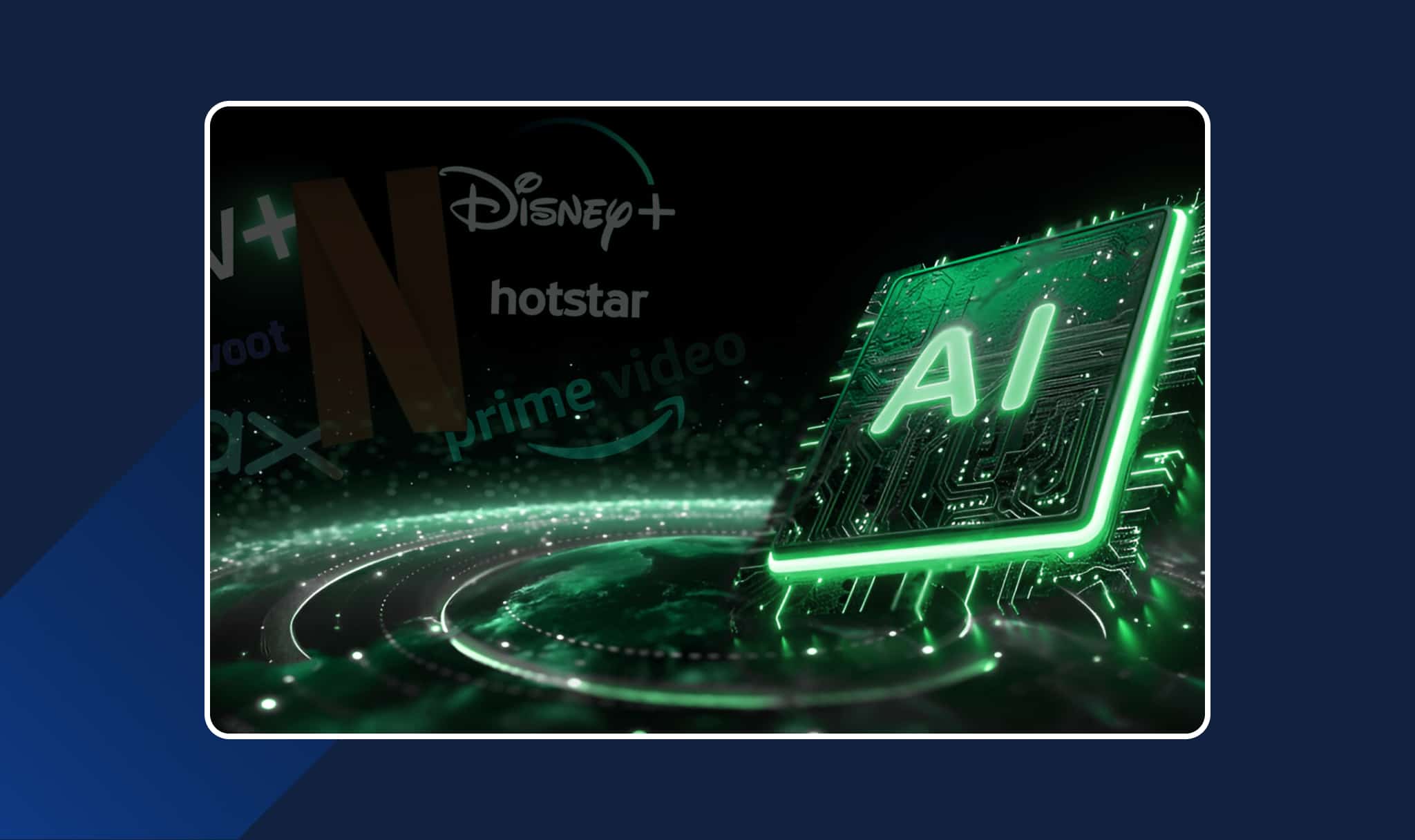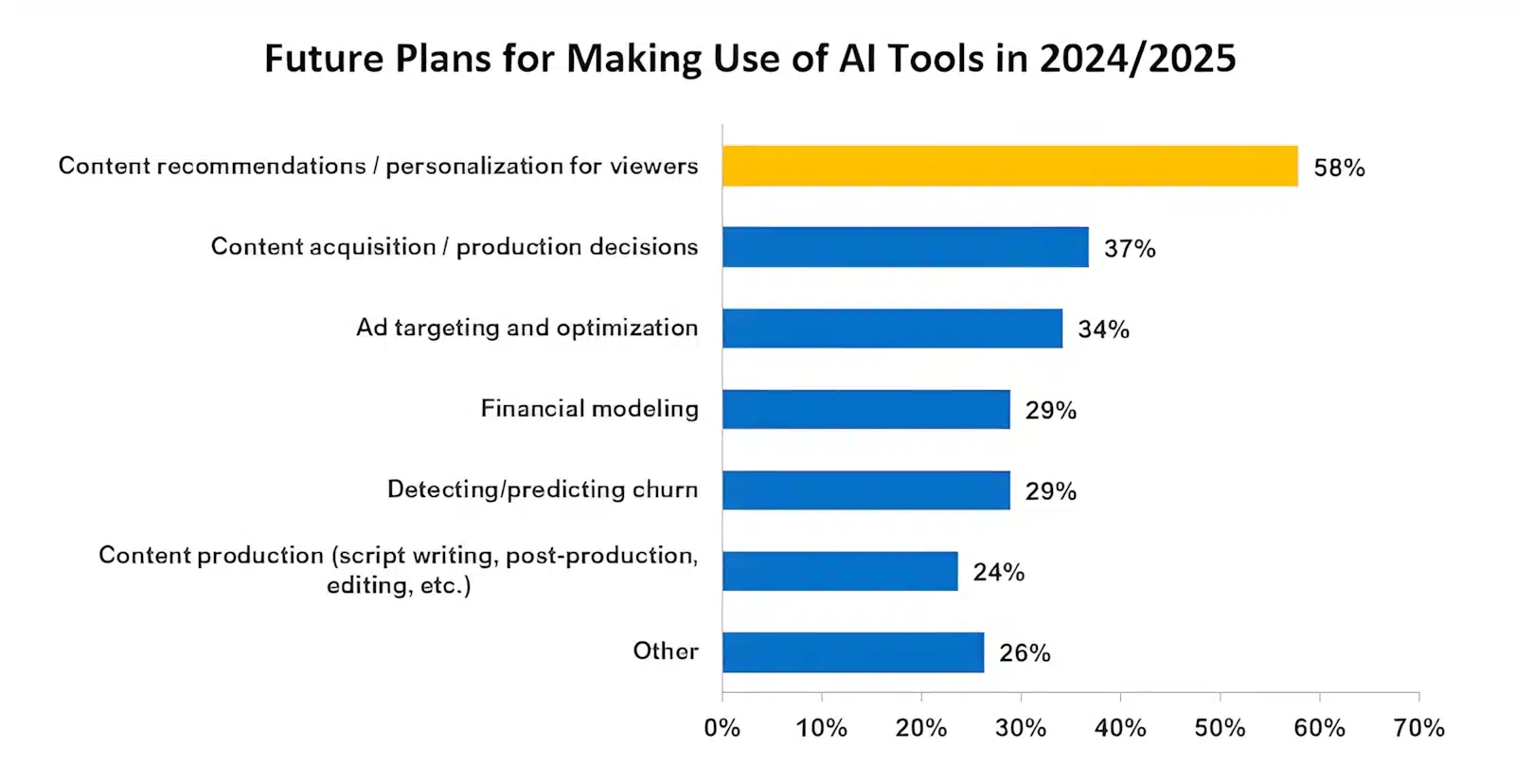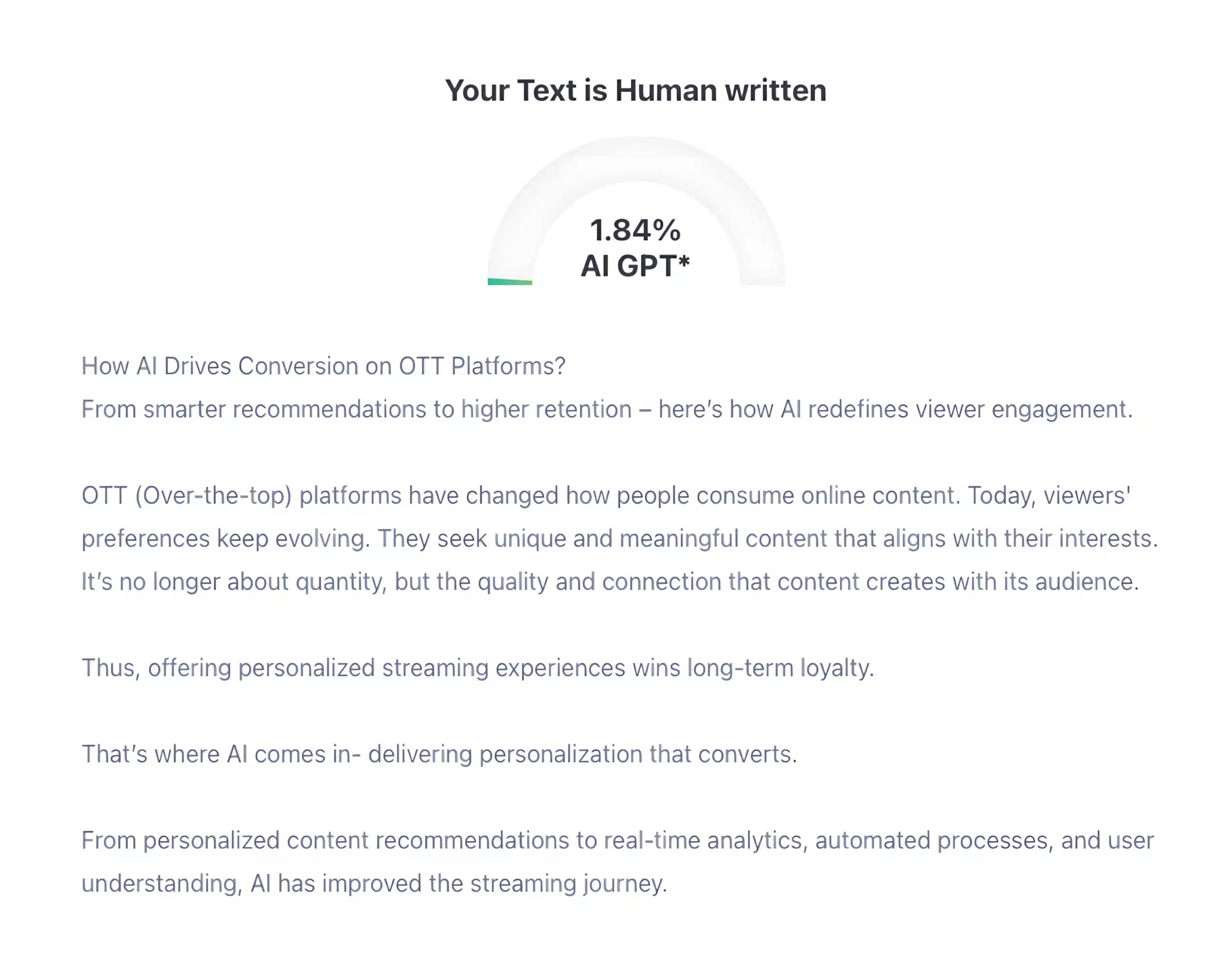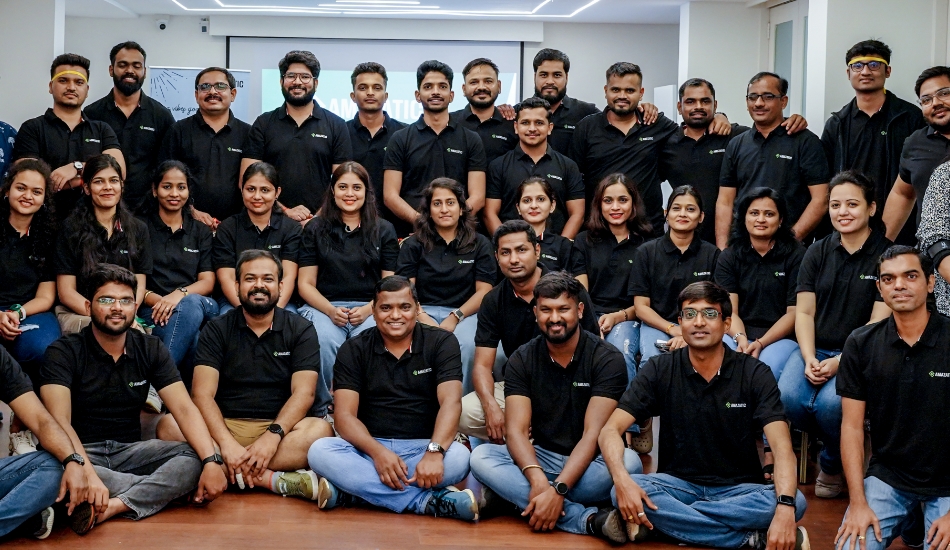
OTT (Over-the-top) platforms have changed how people consume online content. Today, viewers’ preferences keep evolving. They seek unique and meaningful content that aligns with their interests. It’s no longer about quantity, but the quality and connection that content creates with its audience.
Thus, offering personalized streaming experiences wins long-term loyalty.
That’s where AI comes in- delivering personalization that converts.
From personalized content recommendations to real-time analytics, automated processes, and user understanding, AI has improved the streaming journey.

From personalized content recommendations to real-time analytics, automated processes, and user understanding, AI has improved the streaming journey.
AI improves experience and shapes content strategies that resonate directly with target audiences. That’s why leading OTT players (like Netflix, Hulu, Amazon Prime) integrate AI across their operations, making it a game-changer for driving conversions like never before.
China’s OTT strategies use AI to enhance user experiences.
Let’s dive into how AI is transforming OTT conversion in 2025.
First, Understand What “Conversion” means in OTT?
To understand how AI enhances streaming experiences, we must first define what “conversion” means within the OTT context.
The whole point of any investment comes down to the conversion. How much does your app or product convert? The same goes for OTT platforms. From creating to distributing content on OTT platforms requires investment that needs monetization models. With appropriate insights and understanding of viewers’ preferences, these platforms can deliver content strategically. Conversion may vary depending on the business model.
- Free to Paid Subscription – Getting users to upgrade from a free trial or freemium version to a premium subscription.
- Trial to Long-term Subscriber – Ensuring users continue after their initial trial ends.
- Ad Views to Purchases – For AVOD (Ad-supported Video On Demand) platforms, converting ad impressions into product interest or purchases.
- Dormant to Active Users – Re-engaging inactive users through targeted content or offers.
AI targets these touchpoints to boost user retention, enhance content visibility, and improve viewer loyalty. So, how exactly does AI power conversions? Let’s break it down.
The Role of AI in OTT Platforms
1. Hyper-personalized Content Recommendations
With the overcrowded OTT platforms, finding the right content at the right time has become crucial. What if your viewers do not find relevant content and close the app? One viewer lost.
AI in OTT platforms goes beyond static recommendations and provides recommendations based on real-time analysis and evolving preferences. AI in OTT platforms uses machine learning models to generate personalized recommendations based on-
- Watch history, behavior patterns, and viewing sessions.
- Genre and actor affinity
- Time of day, device used, and user mood patterns
For example, Netflix’s AI-based personalized recommendation engine drives 75% of its users. Personalized recommendations reduce decision fatigue, keep users engaged longer, and increase the chance they convert to paying subscribers.
2. Thumbnail Personalization and Dynamic UI in Streaming Platforms
On OTT, the thumbnail and its UI grab the most attention. And that’s exactly what AI is optimizing—not just what you see, but how you see it. With AI, OTT players are transforming the viewing experience and operational efficiency. This is how.
- Thumbnails are no longer static. OTT platforms combine computer vision, A/B testing, and viewer profiling to generate multiple thumbnail variations for the same piece of content. Test them and verify which performs best.
- Customized homepage layout. AI personalizes how they’re arranged and visually prioritized. It rearranges the UI tiles, carousels, and highlights rows based on the user’s behavior and preferences. Some users might see “New Releases” first, while others get “Continue Watching”.
- Cover image personalization. That’s Netflix’s Signature Move, where different users see different visual cues for the same title.
3. Predictive Analytics for Churn Prevention
“Retaining users before they quit”
Understanding users’ behavior is crucial, especially in the OTT industry. Some metrics help you decide which users are going to churn.
- Decreased viewing time
- Lack of interaction with new releases
- Skipping or not finishing shows
AI can analyze these patterns faster, identifying those crucial users who you might lose. To retain such users before it’s too late, platforms must
- Trigger personalized re-engagement campaigns
- Recommend relevant content or offer exclusive deals
- Optimize in-app nudges and notifications
- Push notifications
- Personalized email recommendations
- Split testing
For example, Netflix uses an AI recommendation engine to get in-depth insights about the user demographics and behavior, leading them to build a solid strategy. Today, they have the lowest churn rate of 1-3%.
4. AI-powered Ad Targeting (AVODs Models)
In AVOD (Ad-Supported Video on Demand) platforms like YouTube, Hotstar, Tubi, and Pluto TV, ensuring viewer satisfaction while generating ad-based revenue is challenging. Viewers want free content, without irrelevant ads.
That’s where AI steps in —strategically managing ads to feel more like content and less like a disruption. It makes ads less annoying and more effective. AI helps AVOD platforms
- Deliver hyper-targeted ads that feel more personal based on your watch history, search behavior, location, and device type.
- Scene-Aware Ad Placement for scene detection and audio analysis to find natural pauses or transitions in content.
- Dynamic ad rotation, reducing ad fatigue.
For platforms, it is a win-win: happy viewers and conversion. Platforms like Hulu use AI for ad targeting, improving ad relevance, engagement rates, and overall viewing experience.
5. AI-based Content Monetization Strategies
In the case of OTT platforms, there is no one-size-fits-all pricing or basic subscription. They must analyze data to offer the right thing to the right user at the right time, turning views into revenue smartly. With AI, OTT platforms can build smart content monetization strategies. It involves
- Real-Time A/B Testing
- Predictive upselling, as AI knows the user’s willingness to pay more
- Segment audiences based on their subscription preferences
- Smart paywalls so that more people subscribe instead of dropping off.
- Dynamic pricing plans that maximize revenue while providing value to users
Netflix, Disney+, and HBO Max use AI to tweak pricing, test new bundles, and time their offers, ensuring every viewer sees what they’re most likely to respond to. AI-driven content monetization strategies enable OTT platforms to
- Adapt dynamically to changing market conditions
- Ensuring long-term sustainability
- Growth and conversion
6. Enhanced Discovery via Voice & Visual AI
Most of the time, viewers can’t decide what they look for. With voice and visual AI, OTT platforms improve viewer experience, user interaction, and content discovery. AI-driven NLP and computer vision allow users to
- Search by voice: “Play the movie with the blue genie” → Aladdin
- Browse through AI-tagged visual metadata
- Discover hidden gems based on subtle content affinities
- Understand and interpret user commands and queries
- Use voice commands to search for specific content, control playback, and adjust settings
- Discover new shows based on their preferences
Platforms like Amazon Fire TV use AI-driven voice and image recognition to offer personalized navigation, AI content recommendations, and improved content discovery.
7. Predictive Content Licensing
OTT platforms are always in the race to deliver unique content to keep viewers engaged. This is why they must invest in the right content before it trends. AI-powered predictive analytics for OTT platforms make smarter decisions about what shows and movies to license or renew. AI helps
- Analyzes past viewer behavior and content trends
- Tracks competitor strategies and market dynamics
- Uses machine learning to forecast which titles will perform well
Instead of guessing what’ll be a hit, AI helps platforms predict what viewers will binge, love, and opt for.
- Lower risk on content investment
- Higher ROI on licensing deals
- A more engaging, diverse content library that audiences want
8. AI in Live Streaming
AI is transforming how live content is streamed and experienced on OTT platforms. It improves the viewing experience that goes beyond expectations, optimizing experiences in real-time. AI improves live streaming by
- Auto-adjusting video quality based on viewer bandwidth in real-time
- Reducing latency for near-instant playback and minimal lag
- Auto-captioning and translation for global reach
- Detecting & fixing stream issues before users even notice
The result?
- Fewer interruptions and buffering
- More accessible and immersive live events
- AI for viewer engagement and longer watch times
For example, Twitch reduced 50% latency, offering seamless and glitch-free streaming across devices without delays. Netflix and YouTube use adaptive bitrate streaming powered by AI to reduce buffering by up to 30%.
In the 2022 FIFA World Cup, YouTube Live and Twitch used AI-powered stream monitoring to maintain uptime over 99.9%, even during peak traffic.
9. Automated Content Moderation OTT at Scale
With a million hours of new content uploaded or streamed daily, OTT platforms cannot moderate content manually. But with AI, moderating content at scale, in real time, has become easier. AI helps platforms
- Detect explicit or harmful content (nudity, violence, hate speech) using computer vision and NLP.
- Flag age-inappropriate content before it goes live.
- Auto-classify content ratings across regions — saving time and legal risk.
- Monitor live chats and comments during streams to block toxic behavior or spam.
YouTube’s AI systems review over 500 hours of content uploaded every minute, automatically flagging content that violates guidelines. In 2023, 90% of the videos removed by YouTube were first flagged by AI, not humans.
AI’s impact is non-negotiable. However, AI implementation comes with its challenges that OTT platforms must consider, as it directly deals with audience data.
Challenges of Integrating AI in OTT Platforms
Where AI works like magic, you have to be careful at every step. You must check what it accesses and how it uses the data.
- Implementing AI requires a significant upfront investment.
- Lack of AI expertise.
- AI uses and analyzes users’ data to generate results, which raises privacy and compliance concerns.
- AI models can show bias, leading to unfair content recommendations or visibility.
- Outdated OTT platforms might not communicate well with advanced AI tools.
- Regional content laws and cultural differences make it hard for AI to work the same way everywhere.
- Keep the human touch intact for better content curation and customer experience.
- As AI systems grow, they become more attractive targets for data breaches and manipulation.
Addressing these ethical challenges, OTT players can create trustworthy content that converts instantly.
What’s Next for AI in OTT Platforms?
AI is an evolving landscape offering new ways to perform and operate better. The same goes for OTT platforms. Integrating AI across OTT operations results in OTT user experience optimization and helps them convert those who have been left behind.
From reducing churn rate to multi-lingual streaming, automatic distribution, and more, AI is already defining the OTT industry. Top names like Netflix, Hulu, Amazon, Disney+, and others have showcased their AI journey with success, leaving inspiration for newcomers.
Ready to elevate our OTT platform experience? Consult Amazatic’s OTT AI services.
Learn how we helped other clients in the industry.


